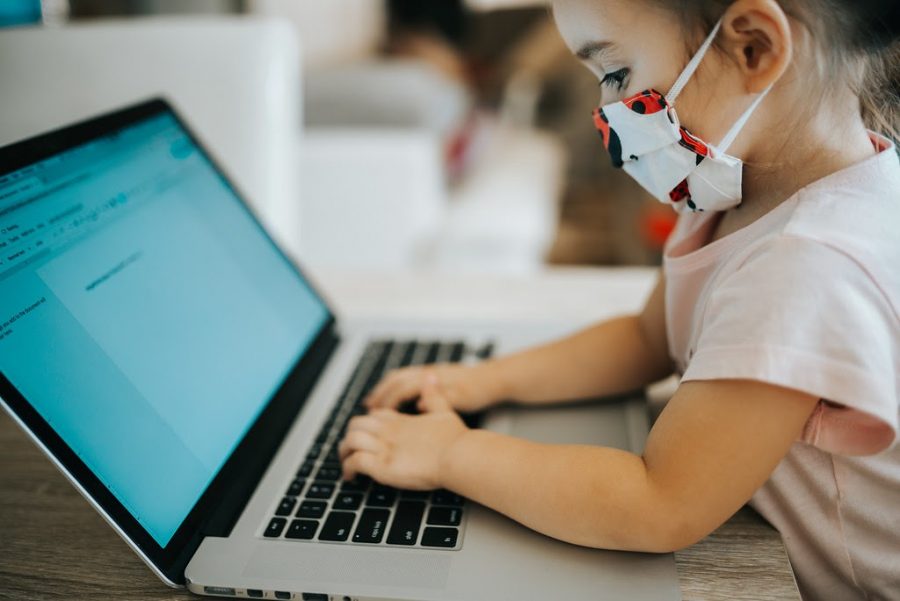Sophomore Voices Guest Series: You Can’t Educate a Human With a Robot
May 17, 2021
Children and teens have always been notorious for being sucked into the vortex of technology addiction. Technology is vital at times, however, too much technology can be harmful to the health and wellbeing of youth. The Coronavirus pandemic has left everyone in the world in a quarantine that seems to be endless. This has caused schools, workplaces, and just general gatherings to become completely virtual. This action has been taken to slow the spread of the deadly Coronavirus. However, there have been many mental and physical health consequences that have been linked to the shift into a completely virtual world. These consequences have impacted youth and their families. Youth have been forced to spend several hours of each day online because of school shutdowns. Though this has been a way to prevent students and teachers from contracting the Coronavirus, it has been detrimental to the education, wellbeing, and health of youth and families alike. Technology combined with the Coronavirus pandemic has hurt society, especially children and adolescents, and in some ways this damage is permanent.
Constant use of technology is harmful to the mental and physical health of teenagers and children. The article “How Social Isolation Is Killing Us;” by Dhruv Khullar includes information about technology use and social isolation; “These effects start early: Socially isolated children have significantly poorer health 20 years later, even after controlling for other factors. All told, loneliness is as important a risk factor for early death as obesity and smoking.” The ever-so growing use of technology amongst youth combined with social distancing and quarantine regulations has created a recipe for social isolation. While physical distancing and quarantine are crucial in preventing the spread of Coronavirus, social isolation caused by always being online is detrimental to the mental and physical health of everyone, especially children and adolescents. As mentioned above, social isolation provides children with almost permanent negative effects. Social isolation causes fatal health consequences, and can even cause people to live shorter. This is a nightmare come true for youth all over the world. In order to save our children, we must find COVID friendly ways to provide them with essential social connections. Youth should put down their phones and get outside and socialize, because it is necessary for the lives of the children and teens of today.
Government mandated lockdowns have caused just about every place that doesn’t sell food to close. Unfortunately, schools have been one of the many places to be closed due to the Coronavirus pandemic. This has caused students to be required to achieve their education online. However, this method of schooling has been ineffective in giving students a quality education. In the article “Children’s Screen Time Has Soared in the Pandemic, Alarming Parents and Researchers” by Matt Ritchel, a detail is included about the situation of a high school student who is participating in online learning, “Fourteen-year-old James is an only child who started high school this fall and said that because of Covid-19 and distance learning, he didn’t have many chances to meet new people. Instead, he hangs out online with his old friends.” Students are losing the ability to socialize during school shutdowns. An absolutely essential need for all people is socialization, whether there is a pandemic or not. Socialization is crucial for stable mental and physical health. School has been the only outlet of socialization for children and teens for many many years. Learning social skills and street smarts through attending school daily is just as important as achieving an education. Since schools are currently closed due to physical distancing and quarantine measures, students have had little to no way of socializing. This has serious consequences. This causes students to lack motivation, and therefore perform worse in their education. I personally know students who have been failing school because of remote learning. Not providing in-person school in a COVID- friendly environment has been, and will continue to be, detrimental to the development, education, and overall livelihoods of students. This is how remote learning is ineffective in giving today’s youth a proper education.
People may say that in-person learning puts students at a very high risk of contracting coronavirus. They claim this because they believe that students are at lower risk of contracting and spreading coronavirus when participating in remote learning due to physical distancing and quarantine, therefore making remote learning better for student’s health. This reasoning in support of remote learning is incorrect because on the other hand, remote learning socially isolates students, which causes horrible mental health disorders in students, which can lead to students facing serious, permanent, or even fatal mental and physical health consequences. Also, it is possible to host in-person schooling while protecting students from coronavirus. Physical distancing measures and required face covering regulations that schools put in place, combined with the young ages of students puts students at a low risk of contracting coronavirus while attending in-person school. This means that in-person schooling not only keeps students protected from coronavirus, it also improves the health of students, therefore making in-person schooling more effective than virtual schooling.
Living in a practically virtual society has been harmful to the young. With schools, businesses, and recreation becoming completely virtual due to the Coronavirus pandemic, many very important aspects of life have been stopped. This is brutal to the development of teenagers and kids of modern society. Also from ”Children’s Screen Time Has Soared in the Pandemic, Alarming Parents and Researchers,” there is a statement that reads, “What concerns researchers, at a minimum, is that the use of devices is a poor substitute for activities known to be central to health, social and physical development, including physical play and other interactions that help children learn how to confront challenging social situations.” This is a very real and dangerous problem in the current generation of youth. Devices are just as addictive and harmful as drugs. Even before the pandemic, technology addiction has been a major concern in teenagers and children. Now, that problem has multiplied by a huge quantity. Children use technology, especially video games and social media, to distract them from the trauma associated with the pandemic, school closures, and the many other tragedies that have defined the year 2020. Also, video games and virtual activities have been a substitute for reality due to social distancing. This raises kids on a false definition of reality. Once the pandemic hopefully ends, children will be unable to handle reality. This is because they’ve been spending their lives in a virtual world rather than a real one. This will cause them to have to readapt to a whole new, reality based society. This will negatively affect their mental health, physical health, social skills, jobs, and education in the long run. As the world continues to exist in a computer, the young generation continues to lack social skills, proper education, and physical activity. Youth today are lacking crucial needs for survival, and that is a huge problem.
This proves that remote learning and lockdowns due to Coronavirus are critically hurting children and teens. Youth shall no longer lack basic survival needs and normal lives, because they are currently suffering from it. Instead, what needs to be done as a society, is that we need to realize that social isolation and mental illness are just as big health problems as COVID-19. There is not only a pandemic of Coronavirus, but also pandemics of underdevelopment, undereducation, depression, anxiety, and technology addiction, and society needs to put an end to it immediately. What should be done is the actions of reopening schools, reopening businesses, and encouraging social interaction. It is very much possible and healthier to observe physical distancing instead of social distancing. Wearing face coverings does not prevent people from talking to each other. In order to truly improve the health and safety of children, we must let them go to school and live at least somewhat normal lives so they can develop like everyone else has and should. Preventing the spread of COVID-19, social isolation, and technology addiction needs to be put into practice immediately to save the lives of the young. This is why in-person school should be available to all students. This is why society should rely less on virtual activities. This is how technology and the transition into a virtual society, including virtual schooling, has negatively affected the youth of current times.





Rob Marx • May 21, 2021 at 1:33 pm
Great article, very thoughtful and well written.
I was camping over the weekend and I saw four or five young people, maybe they were 7-10 in age, chasing frogs and other creatures along the edge of a marsh. Most were jumping from rock to rock to stay out of the muck but some didn’t care and trudged right through water.
It was great to see, not a cell phone in sight.